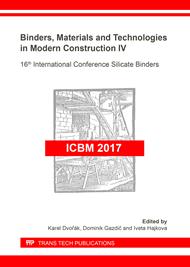p.179
p.185
p.192
p.198
p.204
p.210
p.217
p.223
p.229
The Impact of Addition of Fibers on Reducing the Shrinkage Cracks in Multilayer Renovation Plasters
Abstract:
Renovation plasters need to be characterized by high porosity, appropriate pore size distribution and the ability to transport and accumulate mineral salts. In addition, they must perform functions of a regular plaster. One of the main features that every plaster should have is the resistance to shrinkage cracks. For salt-absorbing plasters, the need to use multiple layers necessitates an in-depth research of this phenomenon. The shrinkage crack formation is determined by the bending strength of mortars. This feature can be adjusted with the addition of different types of fibers. This paper presents a study on the change in bending and compressive strength of renovation plasters with the addition of 6 mm fibers. 0.05, 0.10, 0.15, 0.20% of polyethylene fibers and 0.10, 0.20, 0.30, 0.40% of glass and basalt fibers by mass ratio to dry mix were used. The results were referenced to mortars without fibers. Significant changes in mechanical properties were observed. Compression and bending strength increases with the fiber addition, reaching maximum values at 0.15% for PE and 0.20% for glass and basalt fibers. The best results were obtained for the latter ones.
Info:
Periodical:
Pages:
204-209
Citation:
Online since:
June 2018
Authors:
Keywords:
Price:
Сopyright:
© 2018 Trans Tech Publications Ltd. All Rights Reserved
Share:
Citation:


